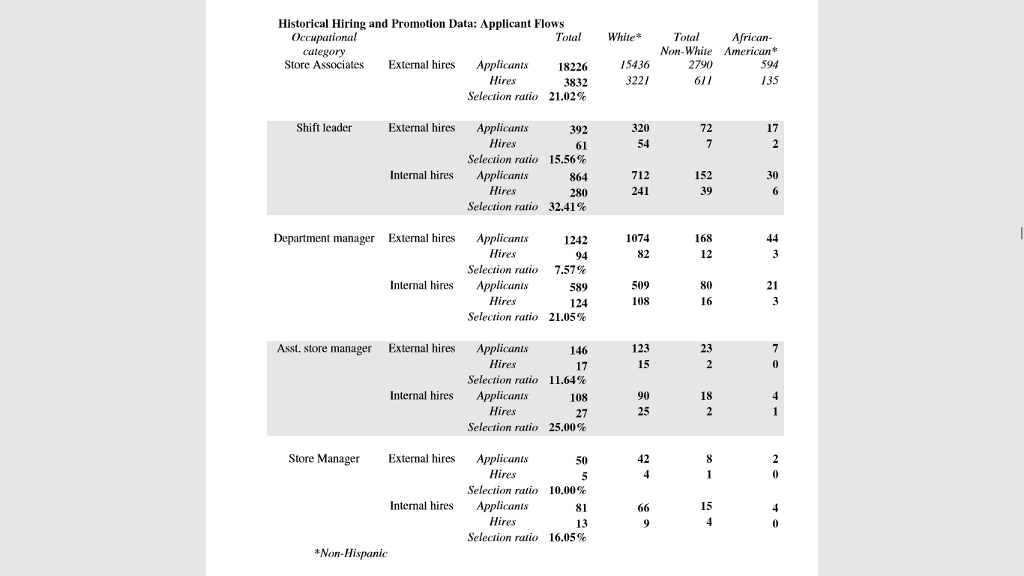Question
Read Case 5: Disparate Impact Analysis from the Tanglewood Casebook. For the job group, you will analyze the information and prepare a report showing the
Read "Case 5: Disparate Impact Analysis" from the Tanglewood Casebook. For the job group, you will analyze the information and prepare a report showing the results of the EEO investigation. The Director asked you to address these questions in
1. Compute flow and concentration statistics. There are two different methods for conducting disparate impact analysis in this case. One is to contrast the representation of White employees compared to non-white employees as a group. Another is to contrast the difference in representation of White employees compared to specific racial/ethnic subgroups (e.g., White compared to African-American). Because the case is being brought specifically on behalf of an African-American plaintiff, this is the most important contrast, but Tanglewood would like to see what the data look like for non-Whites as a whole as well your written report.
2. Examine the selection ratios for all job categories, and determine whether the evidence points to disparate impact discrimination using the 4/5th ratio
Present your findings in a simple one-page memorandum with or without your attached excel workbook or by inserting comments on your worksheets explaining yellow highlighted cells or red text that suggest disparate impact is occurring
Case Objectives
The most significant equal employment opportunity concern for any organization is when a large class of employees gathers together to propose that they have been discriminated against. In this case, you will be able to assess a case of adverse impact proposed by African-American employees of Tanglewood in Northern California. This case will give you an opportunity to use the quantitative material described in your textbook in a more elaborated employment setting.
Simply determining whether an organization has problems related to the diversity of its workforce is a good first step for addressing legal complaints, but it does not resolve the underlying problems that lead to disparate impact in the first place. It is also necessary to develop specific staffing strategies in terms of recruiting and promotion that help to minimize disparate impact. Thus, the second stage of the case incorporates ideas from several chapters to provide a full picture of how organizations can improve diversity.
Recruiting and Hiring for Northern California
The typical recruiting and hiring practices for Northern California are based on a model that has been successful in finding qualified, energetic salespeople and talented managers. When openings occur, there is a two-pronged recruiting approach. First, as an internal method of selection, existing employees are solicited for recommendations. For higher level positions, the internal selection process involves promotion from within. Second, as an external method of selection, advertisements are placed in the popular press and applications are taken from the internet sources.
Final selection decisions are based on a few basic principles as described in other sections of the casebook. One clear concern is that any new employee must fit well with the group into which they are selected. Many managers specifically solicit the opinions of the work group when making hiring decisions. In particular, for higher level positions there are often group interviews. Work skills are seen as trainable, so they are often deemphasized. Instead, the focus is much more on personality and values.
A Legal Conundrum
While Tanglewood central management strongly supports the selection methods utilized in Northern California, the formation of a class action lawsuit is creating a new problem. The national law firm of Eaglette-Schubert has begun to contact many of Tanglewoods Northern California minority employees and encourage them to band together to sue the organization. The initial impetus for this attention was an internal complaint filed by an African-American shift leader from Stockton named Stanley Root, who claimed he was repeatedly passed over for promotion opportunities despite positive performance appraisals. Marilyn Gonzalez attempted to contact Mr. Root several weeks after the complaint was filed, but he told her that because he saw such delayed action from the company on his behalf, he was discussing the matter with Eaglette-Schubert and any comments or questions should be directed to the lawyers who were taking on his case.
Eaglette-Schubert has a long history of successful class action lawsuits against large companies in the retail industry, with some cases resulting in decisions in the millions of dollars. Of course, such high dollar amount cases also usually also mean heavy negative publicity. Upper management is nervous.
The Tanglewood Philosophy
Tanglewood generally prides itself on its openness, inclusiveness, and encouragement of diversity. Tanner Emerson and Thurston Wood both have tried to build the company on a model of inclusiveness, and this means that judgments are made about individuals solely on the basis of work and character. As such, the possibility of a lawsuit presents a real problem for the company. The selection strategy for Northern California is widely seen as a success story within the company, but the company wants to take any steps possible to ensure that it is not engaging in practices that violate the intention to embrace diversity.
The current method for hiring managers involves a targeted recruiting strategy with a strong emphasis on internal selection. Individuals who show particular promise in their work are encouraged to apply for managerial positions when they open up. Although managerial job openings are posted within the organization through in-store bulletin boards as well as e-mail notifications, individuals who are recommended by their current supervisors have a strong advantage in the process. The external recruiting strategy also tends to favor public postings of job availability.
The companys board of directors would ideally like to gain specific information that will definitively show if there is discrimination. If there is evidence that a problem is occurring, the company would prefer to have a low-publicity settlement with minority employees and take steps to improve the climate for minorities. However, if there is not evidence that there is a problem with their hiring methods, they would much prefer to keep their current methods in place.
The Plaintiffs Strategy
The specific details of the case to this point have few details pointing to specific actions or behaviors that suggest overt or intentional discrimination. In fact, Eaglette-Schuberts early communication with the company has suggested they see the problem as arising because the Tanglewood uses an internal network to find new employees and promote those inside the company. The process is therefore potentially closed to minority groups. According to the disparate impact theory of discrimination, there is no need to prove discrimination was intentional, but simply that there is a difference in employment outcomes between groups falling under a protected class.
The Eaglette-Schubert team appears to be using a birds of a feather strategy they have pursued previously to argue for how disparate impact occurred. In effect, they argue that extensive reliance on within-company networks makes many companies prone to discrimination because of homophily in social networks. Homophily is a social psychology term for the widely observed phenomenon that most people seek to be around those who are similar to them. By extension, majority group managers will seek out other majority group individuals to include in their social relationships. This means that a company can engage in wide-ranging discrimination even without overt discriminatory intent, but based on subtle, unobserved preferences. The law firm has used a social psychologist named Frances M. Bosgaw employed at Cornell University in the past. Her research generally supports the appearance of gender-based homophily, but the research is less specific with regards to the subject of race.
The pursuit of this strategy is interpreted as a double-edged sword within Tanglewood. First, as noted by Marilyn Gonzalez, the homophily argument is being pursued because there is no evidence that the company is deliberately acting to discriminate against minorities. The strong diversity statements in the company handbook and the clear consequences that have been shown to individuals who engage in discriminatory behavior are one reason the company has a good reputation in terms of diversity. However, this information may be considered irrelevant, because the Eaglette-Schubert theory of the case doesnt hinge on intentional discrimination. So Tanglewood must take a careful look at their outcomes across multiple jobs and be certain that they are in compliance with the law.
The Next Stage
To assess whether there is a problem with statistical representation of minorities at Tanglewood, the first step is to conduct statistical analyses of current employment practices. The information is presented for store associates, shift leaders, department managers, assistant store managers, and store managers.
Basic Analysis Procedure for EEO
Analyzing disparate impact requires comparing the availability of protected classes (i.e., the proportion of the qualified and available work force who are members of protected classes) to the utilization of protected classes (i.e., the proportion of those hired or employed who are members of protected classes) for each job in the organization. In a flow analysis, data from the organizations hiring practices and applicant pool are used to compare how many individuals were hired from various groups in the applicant pool. In a concentration analysis, the distribution of employees within the organization is assessed.
Selection ratios and the 4/5 rule
One relatively simple way to assess disparate impact is to compare the proportion of applicants who are hired from several sources. This is done by assessing selection ratios as described in Exhibit 2.5 in your textbook.
The Uniform Guidelines in Employee Selection Procedures provides a simple guide to calculate differences in hiring rates. The rule states that if the organizations utilization rate of a minority group is below four-fifths (or 0.80) of the utilization rate for a majority group, disparate impact may exist. To use the 4/5ths rule, divide the hiring rate for two groups.
As an example, assume that you have a total of 100 positions to fill. The applicant pool consists of 52 men and 48 women. You give these applicants a test to determine their physical strength, and find that 39 men and 24 women pass the test and would be hired. In this case, the SRmaj is 3952=0.75, and the SRmin is 2448=0.50. To compute the selection ratio, take 0.500.75=0.67. This is under four-fifths (i.e. 0.80), so disparate impact is said to exist for this strength test. This does not automatically mean that there is discrimination, but it does mean that it is incumbent on the organization to demonstrate that the strength test is actually job related.
Concentration statistics
A second method for assessing disparate impact is examining concentration statistics. The basic procedure is also outlined using Exhibit 2.5 in your textbook. Legal guidelines offer no standard statistical tests to assess concentration statistics. Managers are instead expected to notice if there are different proportions of protected classes across organizational levels. For this case, the biggest problem would be a high concentration of minorities in low level positions coupled with a high concentration of Whites in higher positions. Using gender as an example, if 50% of store associates are women, and only 30% of managers are women, this suggests the promotion system is not open to women. 

Step by Step Solution
There are 3 Steps involved in it
Step: 1

Get Instant Access to Expert-Tailored Solutions
See step-by-step solutions with expert insights and AI powered tools for academic success
Step: 2

Step: 3

Ace Your Homework with AI
Get the answers you need in no time with our AI-driven, step-by-step assistance
Get Started


